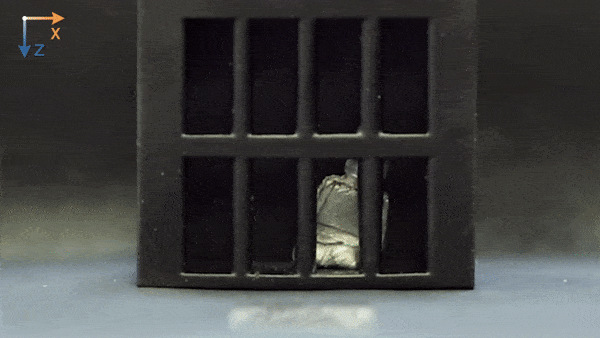Airbus Jr
Banned
Scientists Create Shapeshifting Humanoid Robot That Can Liquefy And Reform
TECH26 January 2023ByMICHELLE STARR
Scientists have made a breakthrough in robotics: a shapeshifting robot that can switch between liquid and metal states to navigate tricky environments without compromising on strength.
Because they can be both soft and hard, the small, sea cucumber-inspired robots can overcome the limitations of robots that are only one or the other, and thus have the potential to provide greater utility in areas such as electronics assembly and even medical applications.
Researchers made the robots navigate obstacle courses, remove or deliver objects to a model of the human stomach, and even liquefy to escape a cage before reforming back into its original humanoid shape.
"Giving robots the ability to switch between liquid and solid states endows them with more functionality," says engineer Chengfeng Pan of The Chinese University of Hong Kong in China.
There are many potential uses for small robots that can get around places too small or convoluted for humans to manage with typical tools, from finicky repair work to targeted drug delivery. But hard materials aren't the best for navigating confined spaces or tight angles, while soft, more flexible robots tend to be weak and more difficult to control.
To find a compromise, a team of researchers led by Pan and his colleague, Qingyuan Wang of Sun Yat-sen University in China, turned to nature as a source of inspiration. Animals such as sea cucumbers can alter the stiffness of their tissues to improve load capacity and limit physical damage, while octopuses can alter the rigidity of their arms for camouflage, object manipulation, and locomotion.
To design a robot that can do something similar, the researchers needed a non-toxic material that can easily shift between soft and rigid states in ambient temperature. They turned to gallium, a soft metal that has a melting point of 29.76 degrees Celsius (85.57 degrees Fahrenheit) at standard pressure – just a few degrees below the average human body temperature. You can melt gallium just by holding it in your hand.
The researchers embedded a gallium matrix with magnetic particles, creating what they call a "magnetoactive solid-liquid phase transitional machine".
"The magnetic particles here have two roles," says mechanical engineer Carmel Majidi of Carnegie Mellon University, one of the senior authors on the team's paper.
"One is that they make the material responsive to an alternating magnetic field, so you can, through induction, heat up the material and cause the phase change. But the magnetic particles also give the robots mobility and the ability to move in response to the magnetic field."
After testing to see whether the transition from solid to liquid was reversible (it was), the researchers ran their little robots through a gamut of tests. The robots could leap over small moats, climb over obstacles, and even split up to perform cooperative tasks moving objects around before recombining and resolidifying.
They even had a little humanoid version – shaped like a Lego figure – melt to escape a little prison cell, seeping through the bars and re-forming on the other side in homage to a scene from the movie Terminator 2.
Next, the team investigated practical applications. They created a model of a human stomach, and had the robot engulf and remove a small object contained within it – a useful way, one imagines, to extract swallowed batteries, for example – and then perform the reverse operation, delivering an object the way the team hopes it might deliver drugs.
For circuit repair, the robots could navigate to and melt onto circuits to act as a conductor and a solder; and even act as a fastener, oozing into threaded screw sockets and solidifying, performing the function of a screw without someone needing to fix it in place.
For real-world applications, the phase-transitional machine would need some tweaking. For example, because the human body is higher than the melting point of pure gallium, a robot designed for biomedical purposes could have a gallium-based alloy matrix that would raise the melting point while maintaining functionality.
That, the researchers say, is yet to be investigated in detail.
"Future work should further explore how these robots could be used within a biomedical context," Majidi says.
"What we're showing are just one-off demonstrations, proofs of concept, but much more study will be required to delve into how this could actually be used for drug delivery or for removing foreign objects."
The research has been published in Matter.

Scientists Create Shapeshifting Humanoid Robot That Can Liquefy And Reform
Scientists have made a breakthrough in robotics: a shapeshifting robot that can switch between liquid and metal states to navigate tricky environments without compromising on strength.
Last edited:

















